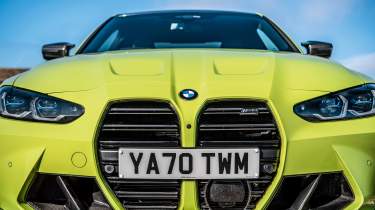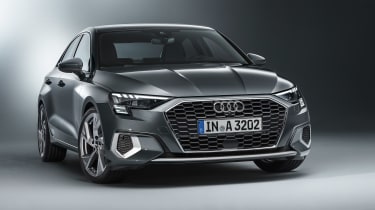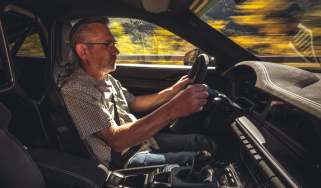How to design a car (part two): front grilles
The grille is one of the most important elements of a car’s design, but why have they become so big, and where will it all end? Peter Stevens shares his thoughts
In almost every car forum, Facebook or Instagram page there are literally thousands of enthusiasts eager to voice an opinion about the direction front grille design is heading. There is also some brilliant Photoshop work suggesting what the final outcomes of the trend to ever larger grilles might be.
Back when the personal transportation device moved from being horse powered to machine motivated it was possible that the propulsive element could be electric, steam or gasoline powered. Setting fire to onboard liquid fossil fuel became the most promising choice. These power units produced a lot of heat as well as power and so the cylinders had to be cooled either by air or water, and a water-cooled engine needed a radiator to act as a heat exchanger to get rid of that heat to the air passing through it. Once the accepted place for the engine became the front of the car, a visible radiator ahead of the motor was the obvious place to put it.
> BMW M4 Competition 2021 review – a super coupe sensation
So here was a chance to distinguish one car from another by using the radiator as a big badge. Manufacturers became very protective of this graphic element, even though its shape and position were fundamentally engineering decisions. During the development of early race and record cars, particularly at Brooklands in England and Montlhéry in France, engineers quickly realised that rather than exposing the whole radiator core, a smooth cowling with a much smaller air intake hole reduced aerodynamic drag without causing overheating, thus producing a faster car.
Until the 1970s Renault in particular, with its rear-engined cars, put the radiator in the back but ahead of the engine. So too did Fiat, Skoda and even Tatra. None of these cars needed a front-mounted radiator but the designers struggled with finding a way to bring character to the front end. Back in the late 1940s when most American cars looked fundamentally similar, General Motors design vice president Harley Earl established the strategy that the front air intake would define each of the differing makes in GM’s world so that they were instantly identifiable either in the rear-view mirror or coming towards you on the other side of the road. Some smart marketing guy seems to have coined the phrase ‘Down the Road Graphic’ (DRG). At that moment the grille became a graphic element rather than an engineering requirement.
In the early 1970s designer Giorgetto Giugiaro’s Mk1 Golf very successfully combined the headlamps with the black plastic front intake grille; the slots in it were only cut through where airflow was actually needed, and a modern, elegant look was achieved that was a huge leap forward from the rear‑engined VW Beetle.
Whilst VW followed this path, Audi, using the same floor pan, eventually separated the grille from the headlights and by 2007 introduced the ‘single frame grille’, with no apparent continuous front bumper. The effect was dramatically different and other companies began following a similar design direction. Once it had become refined, the development of this design feature inevitably only had one direction to go in: it had to grow larger.
With modern car makes becoming more and more difficult to recognise from either the side view or the rear end, the emphasis of visual differentiation is at the front. This is where things appear to have got out of control, and it is the ‘upmarket brands’ that have the most to explain. There are news stories quoting BMW’s senior vice president of project management, Peter Henrich, as saying that feedback on the latest grilles ‘has been very positive’. Yet hundreds disagree, such as BMW buyer Ryan Corman, who voiced his opinion in an online discussion thus: ‘BMW is joining Toyota/Lexus in the “Look at ME!”, every surface “styled” by teenaged anime meth addicts. I will never own a car I can’t stand to look at – I’m one of those guys that likes a car that I feel compelled to look back upon as I walk away from parking it.” This is exactly the phrase that Porsche’s past head of design, Tony Lapine, used when talking about the difference between a car enthusiast and a customer.
Audi, meanwhile, tells us that ‘The design is cited by Audi customers as the no. 1 reason for buying. It therefore plays a central role in the development of new models. The Audi design language is progressive and highly emotional; it expresses the technological competence and quality claim of the brand perfectly. Progress is a seamless connection, deriving aesthetics from efficiency.’ And yet there cannot be an efficiency advantage in the barn-door aerodynamics of a Q8.
Back in 2018, Audi chief designer Andreas Mindt said that the brand intended to leave massive grilles to Toyota, yet many reviews describe the new A3 as being ‘dominated by the large grille’, while enthusiasts have said the current A5 looks like an ‘emoji on wheels’.
There also seems to be a growing trend for grafting grilles reminiscent of those of the Chevy Silverado, GMC Yukon Denali or Ford F250 monster pickup trucks onto SUVs. Is this a desire for the customer to be given the hope or belief that such aggressive-looking front faces indicate an indestructible structure that will protect the occupants in the event of any calamity, swallow rabid dogs in one gulp or consume screaming babies? Or is it the last chance for designers to express the rugged masculinity of their ideas before we are all emasculated by the dull efficiency of the electric car? Cooling air of some sort is needed by the batteries and drivetrain of an electric vehicle as keeping the temperature of these components carefully regulated is essential to their efficient working, but this can be ducted from almost anywhere, meaning that the faux grille could still be with us for a long time yet.
More cynically, could all this extreme style excess be supported by company sales figures that seem to suggest customer satisfaction with the products? If so, it’s worth remembering that the majority of those who sign up to the seductive lease deals on these cars have no option but to trade in their two or three-year-old car for a new one from the same manufacturer or risk losing all the residual value in their car. So maybe they are not as keen as the numbers suggest.





